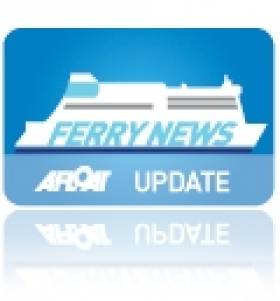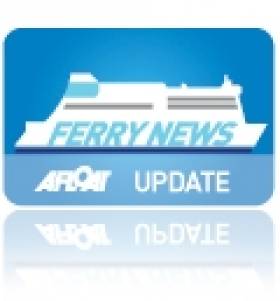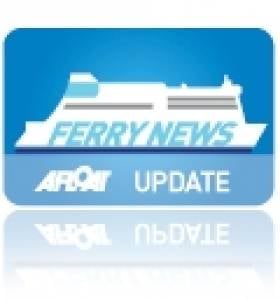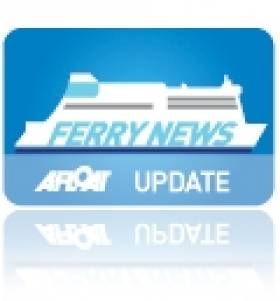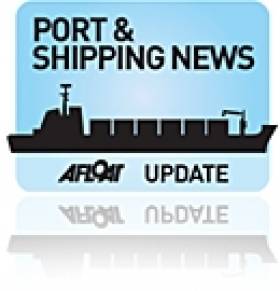Displaying items by tag: Flagship PontAven
Brittany Ferries Flagship ‘Pont-Aven’ On Its 20th Year Returns to Service the Cork-Roscoff Route
Pont-Aven Brittany Ferries impressive flagship at the weekend resumed its first Roscoff-Cork round-trip this season, in the 20th anniversary year since its introduction on the Ireland-France route and UK-France/Spain links, writes Jehan Ashmore.
During Pont-Aven’s return leg to France on Friday-Saturday, it was just a day short of its two-decade-old service date of March 24, 2004, which saw the 2,400 passenger, 650 car, and 85 lorry flagship also make its Irish debut the following month on the Ireland-France connection.
The 40,859 gross tonnage flagship with a Breton registry of Morlaix, was built by Meyer Werft, Papenburg, Germany for BAI S.A. (Bretagne-Angleterre-Irlande), trading as Brittany Ferries. Its introduction marked a significant chapter for the company, which has built up its brand and a strong relationship, including culturally with Ireland, for more than 45 years. This began with the Munster-Brittany link launched in 1978.
At the weekend, Pont-Aven’s return crossing from Cork was tracked off Land’s End, Cornwall, England, from where the flagship also made its debut in 2004 in neighbouring Devon on the Plymouth-Roscoff route and the Plymouth-Santander service.
The 10-deck flagship continues to be one of the most luxurious operating to mainland Europe, despite the introduction of Brittany Ferries new chartered tonnage from Stena RoRo’s E-Flexer class. They are spacious, modern, and have more environmental merit, yet they do not compensate for the level of cruise-ferry that Pont-Aven provides.
With a service speed of 23 knots, though capable of 27 knots, Pont-Aven has the capacity to keep to its intensive route network of connecting France-UK-Spain routes and the additional France-Ireland round trips.
Over the winter, a 3m 'duck tail' was added to the stern to improve operational efficiency and environmental benefits, which is expected to achieve a 10% reduction in fuel and save costs. Also on the matter of the environment is when in 2016 was installed 'scrubber’ sulphur emission reduction technology, which is welcomed, though considerably altered the external aesthetics of the original funnel that is shrouded in a cage-like structure, which is somewhat ungainly.
Overall, having said that, Pont-Aven presents a sleek profile to a ship with a pleasant-sounding name, which refers to the small Breton town made synonymous with artists, and this is reflected throughout the flagship’s interior décor - Afloat will have more about such features.
Since 2022, the flagship has been joined by the cruise ferry Armorique, which, coupled with extending the season, offers more sailings and choice to holidaymakers. Also, this season sees a first for Armorique to feature 18 pet-friendly cabins due to surging demand, as until now, dogs have had to remain in cars during the crossing, whereas Pont-Aven already has 28 pet-friendly cabins.
The route complements Brittany’s Rosslare-Cherbourg route and the longer link to Bilbao in northern Spain, for which Afloat consulted the company’s sailing schedules, sees its first ‘outbound’ sailing reinstated tomorrow, 27 March, operated by Santoña.
As for the first ‘inbound’ sailing, this departs Bilbao the following day, 28 March, and is to be served by Galicia. Up until then, the route across the Bay of Biscay was closed to enable port-related infrastructure works, which led to a temporary Ireland-Spain service retaining Rosslare as the Irish port but redirecting the route instead to Santander.
Both of these Ireland-Spain ferries are of the E-Flexer class, in which the company also has Salamanca and two more newbuilds to enter service, though on English Channel routes replacing ageing tonnage.
Brittany Ferries Flagship Cruiseferry Pont-Aven Paints a Picture of Service 10 Years On
#PontAven10years – This day ten years ago Brittany Ferries flagship cruiseferry Pont-Aven, was named in a ceremony, by her Breton owners in Roscoff, from where the luxury vessel sailed last night to Cork Harbour and returns to France this afternoon, writes Jehan Ashmore.
Pont-Aven is named after an attractive small Breton town also known as the 'cité des peintres' as the location drew artists to sketch its picturesque scenery.
Among those drawn to paint scenes of Pont-Aven were Monet and the flagship celebrates the heritage of its namesake through of course it paintings, even boosting among its artwork collection a painting by Gaugin.
She was designed primarily for the UK-Spain market in which she made her maiden voyage from Plymouth to Santander on 24 March 2004, with crowds lining Plymouth harbour to cheer her off.
Further maiden voyages included her English Channel route from Plymouth to Roscoff which included a reception on 27 March. She made her 'Irish' maiden crossing to Cork's Ringaskiddy Ferry Terminal arriving on 2 April. Later that month, on 26 April she was officially named in Roscoff.
A decade on and at 41,700 tonnes, the 184m Pont-Aven, remains an impressive vessel within Brittany Ferries modern fleet. She has a 2,400 passenger capacity and crew of 470 which service the luxurious facilities which can easily be described as cruiseferry standards.
Pont-Aven is unique to any cruiseferry serving Ireland as she features the Finistère indoor swimming pool offering sea-views on a high-deck and with an adjoining bar.
Also among her extensive amenities is Le Fastnet Piano Bar to reflect her Irish trading route connections with her season-only sailing schedule operating to a weekend round-trip from Roscoff to Cork.
Pont-Aven was custom-built for Britanny Ferries by Meyer Werft shipyward in Papenburg, Germany, to serve the UK-Spain market as well to the Breton-Cornwall link between Roscoff and Plymouth.
The western Engish Channel route was Brittany Ferries first route in 1973 with its origins stemming from exporting Breton vegetable produce to the UK market. Since then the company have dramatically expanded to offer gite, cottages, chalets holidays and more.
The Irish service followed five years afterwards and the Roscoff-Cork route is currently the only ferry route from Munster and therefore the longest continous operating service since its inception in 1978.
In addition to the the Irish route, Pont-Aven is kept busy linking three other nations on an intensive schedule. In order to maintain the sailing roster, the 28 knot Pont-Aven can achieve this from an engine power of 50,400 kW and propulsion power of 43,200 kW.
#BrittanyFerries35th – Today Brittany Ferries celebrates launching into its 35th year in operating the Cork-Roscoff seasonal service served by 'flagship' Pont-Aven, writes Jehan Ashmore.
Speaking about the upcoming 2013 season, General Manager of Brittany Ferries, Mr Hugh Bruton said: "This is always a busy time for us as we re-commence our service from Cork to Roscoff. We are delighted to report that the route is currently ahead by 12% on last year which is a great sign for The Gathering!
"It's also an exciting time for the business as we are celebrating our 40th anniversary globally and 35 years of sailing from Cork to Roscoff. Our continued service offers affordable, convenient holidays to France which is perfect for families of all ages".
Pont-Aven, is not just 'any' ferry as at 41,000 tonnes, she has an array of luxurious facilities to include a spa and swimming pool and an on board ambiance of French flair combined with a bilingual crew.
The flagship departs every Saturday from Ringaskiddy Ferry Terminal until November 2013. She offers the shortest and fastest route between Ireland and France, taking 14 hours, several hours shorter than rivals running routes from Rosslare.
The origins of Brittany Ferries can be directly derived to Breton vegetable farmers who wanted to export their produce to markets in the UK following the closure of other west English Channel ferry routes more than forty years ago.
A co-operative of French farmers got to together to form Bretagne-Angleterre Irlande (B.A.I) otherwise as we know today as Brittany Ferries, which started a new service to Plymouth in 1973.
Brittany Ferries soon found demand not just from agricultural exports but in the reverse direction with passengers from the UK which really boosted the fortunes of the company. On foot of this success and within the next few years further routes were added to include its first route to Ireland opened in 1978.
Armorique, Quiberon, Bretagne and Val de Loire are not just nice-sounding names from locations in Brittany and beyond to conjure images and memories of travels past but these placenames were also given to name the ferries that served the route down through the decades.
The route has also brought closer ties through Irish-Gallic history and heritage but also Celtic cultural connections.
For more information on Brittany Ferries 2013 season schedule and more visit www.brittanyferries.ie
Brittany Ferries 'Flagship' Sets Sail for Summer Season
#FERRY TO FRANCE – Brittany Ferries flagship Cork-Roscoff route is underway, as the first sailing in 2012 of the seasonal-only operated service started last weekend and runs to early November. Serving on the 14 hour route which is the shortest sailing to France, is the luxurious flagship Pont-Aven, writes Jehan Ashmore.
The 2,400 passenger /650 vehicle capacity Pont-Aven is unique to Irish services as she features a swimming pool. The indoor facility located on the top deck, includes a leisure area and pool bar which is open during the summer season and on busy off-season crossings.
In addition there are restaurants, a piano bar, main lounge, café and shop facilities. She has a wide choice of cabin accommodation that includes 'Commodore' cabins complete with balconies. For details about sailing schedules click HERE.
Roscoff is set in picturesque surroundings on the north-west Breton coast and the ferryport is a short distance even by foot to the town which has restaurants facing the coast. There is a botanical garden and a century-old thalassotherapy that has seawater and seaweed treatments used for healing and relaxation therapies.
French Routes Rivals Vie for Market-Share
#FERRY NEWS- Established ferry operators on routes to France are gearing –up for market share with the first battle for 2012 targeting the Spring Easter period, with recent T.V. advert campaigns launched by Irish Ferries and Brittany Ferries, writes Jehan Ashmore.
Last week Irish Ferries reopened Rosslare-Cherbourg sailings by the cruiseferry Oscar Wilde (1987/31,914grt). The largest ever vessel to serve Irish Ferries French routes will also resume high-season sailings to Roscoff in May. For sailing times of both routes click HERE.
Brittany Ferries will embark their season with Cork-Roscoff sailings on 31st March with 'flagship' Pont-Aven (2004/41,748grt). This route operates a single weekend round-trip schedule, with arrivals and departures to Cork each Saturday, for more on sailings click HERE.
While Celtic Link Ferries, which entered the continental sector in 2005 having taken over from P&O (Irish Sea) introduced a new vessel on the Rosslare-Cherbourg route last October with the chartered ro-pax Celtic Horizon (2006/27,522grt) as previously reported on Afloat.ie.
Unlike their rivals, Celtic Link Ferries are the only operator to maintain year-round sailings in this sector, for schedule click HERE.
Winter's French 'Ferry' Connections
Direct continental ferry services between Ireland and France will be reduced as of this weekend, writes Jehan Ashmore.
Brittany Ferries last sailing for this year on the Cork-Roscoff route ends today. The 11-hour route is normally served by 'flagship' Pont-Aven but this weekend's final round-trip will be operated by the Bretagne. The former flagship, built in 1989 had served on the Irish route for several years but now operates St.Malo-Portsmouth sailings. Cork-Roscoff sailings resume in 2011 with the first crossing from the Breton port on 1 April 2011 and the corresponding departure from Ireland on 2 April.
In the interim period, alternative routes to France are maintained by Irish Ferries and Celtic Link Ferries. On the Rosslare-Cherbourg route, operated by Irish Ferries, sailings are scheduled to run to 31 December but there will be no sailings throughout January 2011 and up to mid-February. This is to allow the routes cruiseferry Oscar Wilde to undergo annual dry-docking before re-opening the route on 16 February. In addition Irish Ferries operate the seasonal Rosslare-Roscoff route which starts on 13 May.
Celtic Link Ferries also operate on the Rosslare-Cherbourg route. During January 2011, the company will be the only ferry operator providing services between Ireland and France.
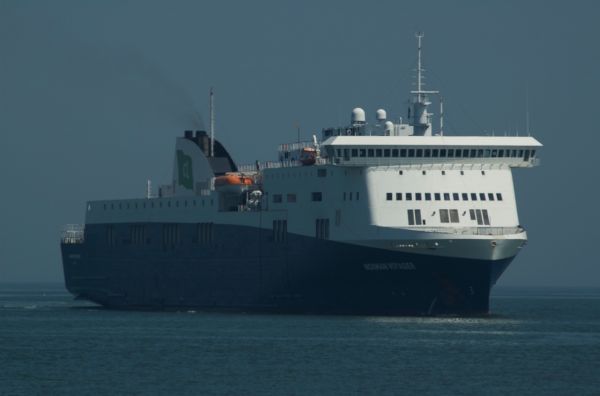
Celtic Link Ferries ro-pax Norman Voyager
The 17-hour route to Cherbourg is served by the 2008-built ro-pax Norman Voyager, the newest vessel on the continental routes. Norman Voyager accommodates 800 passengers, 200 cars and up to 120 freight vehicles. There are 110 cabins and facilities for passengers include a bar, restaurant, lounges, cinema and a shop.


























